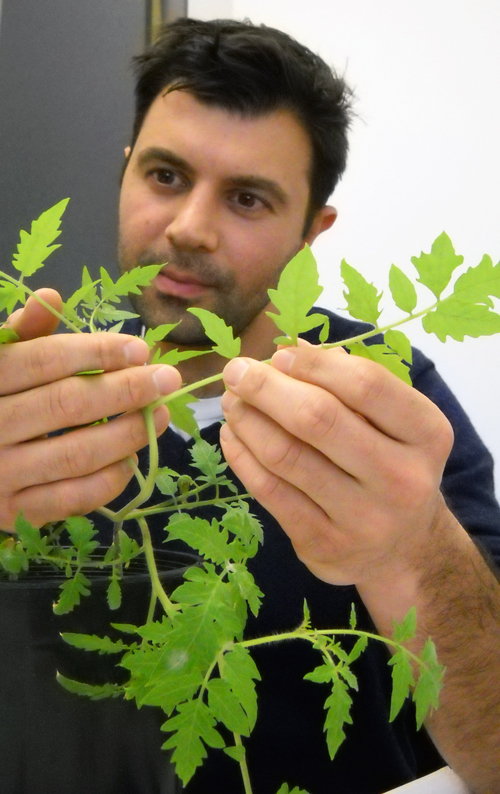
Today he claims a passion for plant biochemistry. But growing up in Toronto, Tariq Akhtar often found himself tending his mother’s vegetable and flower gardens with something less than zealousness.
“She would put me to work in her garden for hours and hours. At the time, I would rather have been playing road hockey with my friends.”
What does Mom think of his having become a plant biologist? “We laugh about it all the time.”
Newly arrived last fall as a professor in the Department of Molecular and Cellular Biology, Akhtar studies chemicals that enable plants to survive and whose products improve our lives — and even allow us to go on living as well.
He’s interested in molecular and genetic pathways underpinning metabolism, or the biochemical reactions that allow plants to grow, develop, reproduce and defend themselves.
That’s mostly basic research, including attempts to fill in what he says is a surprisingly large gap in understanding the role of genes in plant metabolism.
But his studies also connect to real-world issues in nutrition, pharmaceuticals and industry.
Folic acid, or folate, is an essential vitamin that our bodies cannot make. Humans need to acquire the substance from their diet or supplements. It’s prevalent in leafy greens and in microbes such as those found in dairy products.
Millions of people in developing countries lack the recommended daily amounts of this nutrient. During pregnancy, folate is required for proper neural tube development in the fetus.
Says Akhtar: “A lot of young moms don’t get enough folate. It’s a large problem in developing countries where access to nutritious food is sometimes limited.”
After his undergrad and master’s degrees at the University of Waterloo, he studied plant folate metabolism for his PhD at the University of Florida. There he worked with Andrew Hanson, who Akhtar says is considered among the best plant biochemists in North America.
Hanson and other researchers are seeking a cost-effective way to address global folate malnutrition.
One promising avenue is genetic engineering, or “bio-fortification,” to help boost plants’ production of this essential nutrient. “To do that, we have to understand how vitamins are made and how they are degraded and recycled.”
He studied other aspects of metabolism during a post-doc with Eran Pichersky at the University of Michigan.
Consider two parts to plants’ inner workings, he says. One part is primary metabolism, involving basic biochemistry done by all organisms in order to live. Another part – the one that interests Akhtar – involves secondary metabolism
For a long time, scientists viewed secondary metabolites as nothing more than waste products of the biochemistry of living things. Now biologists see these substances – more properly called specialized metabolites — as useful in helping plants survive predatory and environmental challenges.
At Michigan, Akhtar looked at terpenes, or volatile compounds that make up one of the largest known groups of secondary metabolites.
These are substances that lend scent to plants. “You encounter terpenes every day,” he says. They’re what make the tomato plant on his windowsill smell like a tomato. And they’re what give that orange on his desk its orangey tang.
Those scents often attract pollinating insects and other organisms. But plants also use terpenes for the opposite function.
Crush a tomato leaf or stem between your fingers and you release terpenes from tiny appendages called trichromes. At worst, you end up smelling like a tomato.
For certain insect pests, those metabolites can cause sickness and even death. The plant has evolved those terpenes to thwart predators – an example of how plants handle varied threats to survival.
“I’m fascinated by how plants respond to their environment,” says Akhtar. “The underlying chemistry they do allows them to deal with a changing environment. Unlike people who can run away from noxious environments, plants are rooted to the ground and have to be clever to survive in some of the most incredibly challenging environments on Earth.”
He’s interested in the basic biochemistry, including identifying and learning about the genes responsible for making these substances. Other researchers might use that knowledge to wield biotechnology or smarter breeding in order to make plants with desired traits.
Now at Guelph, he plans to pursue interests in a group of specialized metabolites called polyisoprenoids. Natural rubber is an example. They’re found in many plants, but, he says, “We don’t know how plants make them or what their biological function is.”
He’ll conduct that work in special facilities here, notably what he calls “probably one of the most impressive combinations of greenhouses, growth rooms and growth chambers that I’ve ever encountered.”
After eight years in the United States, Akhtar was missing home. U of G isn’t entirely new to him: he had worked during his master’s on environmental toxicology with Keith Solomon, now professor emeritus in the School of Environmental Sciences.
“I think Guelph is the premier agricultural school in Canada,” says Akhtar. “It has a strong presence in plant biology and biochemistry.”